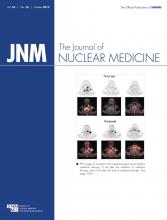REPLY: We thank Drs. Cheng and Alavi for adding and corroborating interesting points of discussion. We completely agree with the authors that the sensitivity and specificity of 18F-FDG PET would be much lower in patients without a prior diagnosis of a cardiac tumor by morphologic imaging. Our results are restricted to patients with known cardiac tumors. 18F-FDG PET is certainly not going to be the first-line procedure for excluding cardiac involvement in patients with known or suspected malignancy elsewhere.
Physiologic myocardial uptake was not so great an obstacle as suggested in the letter. It has to be kept in mind that the location of the tumor was known by morphologic imaging. In some cases, regional physiologic uptake in the myocardium was observed, but as reported, the vicinity of the tumors showed a mean myocardial uptake of as low as 2.1 ± 0.6 standardized uptake value (SUV) (1). Peritumoral myocardial dysfunction might be discussed as an explanation of this finding, but in the absence of further evidence this assumption was not discussed in the article.
Nevertheless, we support the concept of a prolonged fasting period.
Sarcoidosis is certainly a condition that may mimic malignant disease. Patient inclusion criteria were primarily based on morphologic imaging. The probability of sarcoidosis was low according to imaging and clinical information. The differential diagnosis was therefore no major problem in this series of patients. In that context it has to be emphasized that sufficient results in functional imaging can be obtained only with state-of-the-art morphologic imaging techniques in the background.
Tumor biopsy was performed before 18F-FDG PET/CT in 3 of 24 patients: almost 2 mo before PET/CT in one of these patients and within 1 wk in the other two. In all patients, the tumors had a malignant histology, and the smallest tumor had a maximum diameter of 5.6 cm. There is no evidence that inclusion of these 3 patients systematically affect the results of the study.
We completely agree with Drs. Cheng and Alavi that the proposed cutoff of 3.5 SUV cannot be applied to an unselected population to screen for myocardial malignancy. Maximum SUV depends on many factors such as scanner resolution, lesion size, scan delay after injection, and the use of motion correction. The cutoff is valid only in the technical and clinical setting described in detail in the article. We thank Drs. Cheng and Alavi for emphasizing this important issue.
Footnotes
Published online Aug. 23, 2012.
- © 2012 by the Society of Nuclear Medicine and Molecular Imaging, Inc.
REFERENCE
- 1.↵







